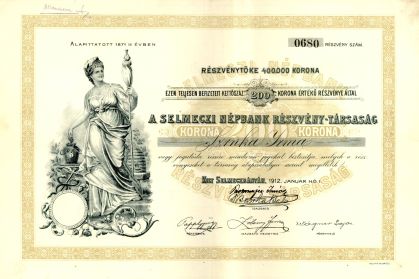The NBS Archives are open to the public at the following times:
Tuesday, Wednesday and Thursday
9 a.m. to 12 noon /
12:45 p.m. to 3 p.m.
In July, August and September the Archives are closed to the public.
The Archives will be closed to the public from December 16, 2025 to January 16, 2026.
Banskoštiavnická ľudová banka, Banská Štiavnica
This financial institution was established on 2 May 1871 under the name Vzájomná pomocná spoločnosť (Mutual Savings Society). In 1876 it was renamed Banskoštiavnická ľudová banka (Banská Štiavnica People’s Bank), joint stock company. Its share capital amounted to 40 thousand guldens and was composed of two thousand shares at 20 guldens each. The bank’s founders were Hungarian wholesalers and farmers from the town and its vicinity. For many years, the bank’s director was Viliam Krausz, succeeded by Ján Pachmajer in 1911. Gradually, two branches of the bank were opened, one in Bátovce and the other in Svätý Ondrej (today part of the town Brusno). The Bátovce branch was established on 18 December 1913 and became operational on 3 February 1914. Its first director was Ján Jesenský.
According to the bank’s articles, the general meeting convened twice a year, the board of directors met once a week. The board of directors comprised the director, his deputy, the treasurer, the inspector and five other members. The bank’s share capital gradually increased and in 1896 amounted to 150,000 Austro-Hungarian crowns (K).
In 1889 a pension fund was established for the bank’s employees. The notice period given by the bank was six months, by employees three months. Employees were entitled to a month’s leave. In sickness, employees were paid a full salary for six months. The working hours were from 9 to 12 a.m. and from 2 to 5 p.m. Holidays and market days were days off. In 1910, a director’s salary was K 1,000 plus a bonus of K 250.

The bank offered term deposits with a term of at least four years; in the last year of the term the deposit rate was 4.5%. In 1912, deposit rates were at 5%. As to lending activities, it was possible to borrow a minimum of K 4, with a maximum repayment period of six months. From 1910 the bank introduced a new savings programme – 50 hellers a week. In that year, there were 399 savers interested in the programme.
After the First World War broke out, the bank granted war loans of K 401,800; in 1915 it provided a further K 432,000. In that same year, the bank succeeded in purchasing three multi-storey houses in Budapest and a large farm estate. However, it almost suspended its lending activities.
In 1916, the bank sold two houses in Budapest and bought another farm estate. In 1918, the Bátovce branch started financing a food cooperative. The cooperative facilitated food trade for Bátovce and its vicinity. In that period, the bank’s equity capital increased to K 700,000. The bank provided the municipality of Banská Štiavnica a food loan of K 1 million. The bank sold its estate in Pomázie and the so-called Tibély House and used the proceeds for the eighth war loan, which amounted to almost K 700,000. In total, the bank lent K 2,649,700 in war loans. At the same time, it supported its employees providing them with a war financial aid – permanent employees received a clothing allowance of K 100, members of their families K 400, temporary employees and interns were given K 200, K 400 or K 500, and attendants K 900. Permanent employees could also receive an extraordinary aid of K 600, temporary employees and interns K 120 and K 200, respectively, and attendants K 100.
The year 1919 was deeply affected by the war and its effects. The bank’s employees were given an extra pay of 300 crowns to compensate for high prices, which was later increased to 400 crowns. The following year saw an improved situation and deposits increased by 1.15 million crowns. The bank also financed a profit-making sawmill in Žarnovica. However, the changed economic situation, rising prices and higher operational costs led to considerations about a merger with stronger financial institutions. Preliminary merger talks started with Banskoštiavnická sporiteľňa; a takeover by Hospodárska banka in Bratislava was also considered.
The terms for a merger with Hospodárska banka, Bratislava were agreed at general meetings held in 1921. Shareholders of Banskoštiavnická ľudová banka exchanged their shares for the shares of Hospodárska banka in the ratio 2:1 and remained entitled to a payment of full dividends for 1921. Hospodárska banka took on all the employees of Banskoštiavnická ľudová banka, as well as its pension fund. Banskoštiavnická ľudová banka became a subsidiary of Hospodárska banka, administered by Ludvík Wágner and his deputy Hugo Balás. The board of directors of the subsidiary had 20 members and its committee 30 members; a half of board members and 20 committee members were from Banskoštiavnická ľudová banka. The sawmill in Žarnovica was transferred to Hospodárska banka and the Bátovce branch became a branch of Hospodárska banka. The merger took effect from 1 August 1921 and the company was removed from the Companies Register (of the District Court in Banská Bystrica) on 4 February 1922. The Bátovce branch eventually ceased to exist after the merger and there is no information recording its further activities.
Preserved documents of Banskoštiavnická ľudová banka were archived in the corporate archives of Štátna banka československá in Ružomberok. Their first temporary inventory was made in 1968, and revised and supplemented in 2015. In 1995 the bank’s archive fonds was moved to the Archives of Národná banka Slovenska located at 27 Krajná Street in Bratislava and in 2003 to its premises at 8 Cukrová Street.
The fonds consists of 14 books and two boxes of files. These are mainly minutes of bank management meetings, the articles of association and annual reports, as well as loan documents.


